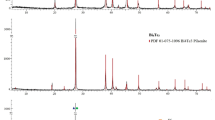Abstract
Empirical electronic polarizabilities allow the prediction of total mineral polarizabilities and mean refractive indices of the vast majority of minerals and synthetic oxides. However, deviations from the valence-sum rule at cations in some minerals are associated with large deviations of observed from calculated total polarizabilities. We have identified several groups of minerals and compounds where deviations from the valence-sum rule at cations lead to polarizability deviations of 2–5%: M(SO4)·nH2O, n = 1–6, blödite-group minerals [Na2M2+(SO4)2·4H2O], and the kieserite-related minerals: isokite, panasqueiraite and tilasite. In these minerals, the environment of the M ions contains both O and H2O: Mg[O4(H2O)2] in kieserite, szmikite, and szomolnokite; Mg[O2(H2O)4] in starkeyite, ilesite, and rozenite, and Mg[(H2O)6] in hexahydrite. In compounds where the ligands are only H2O, deviations from the valence-sum rule at the M(H2O)6 groups are not accompanied by significant polarizability deviations. This is the case for epsomite, MgSO4·7H2O; bieberite, CoSO4·7H2O; goslarite, ZnSO4·7H2O, six silicofluorides, MSiF6·6H2O; eighteen Tutton’s salts, M2M′(SO4)2·6H2O, where M = K, Rb, Cs and M′ = Mg, Mn, Fe, Co, Ni, Cu, and Zn; and eleven MM′(SO4)2·12H2O alums, where M = Na, K, Rb and Cs, and M′ = Al, Cr, Ga and In. This is also the case for the sulfates alunogen, Al2(SO4)3·17H2O and halotrichite, FeAl2(SO4)4·22H2O; three hydrated nitrates; one phosphate; three antimonates and two hydrated perchlorates. A possible explanation for this different behavior is that the bond-valence model treats O and H separately, whereas polarizability calculations treat the polarizability of the entire H2O molecule.



Similar content being viewed by others
References
Bechtold A, Wildner M (2016) Crystal chemistry of the kieserite–cobaltkieserite solid solution, Mg1−x Co x (SO4)·H2O well-behaved oddities. Eur J Mineral 28:43–52
Bosi F (2014) Mean bond length variation in crystal structures: a bond valence approach. Acta Crystallogr B 70:697–704
Bosi F, Belardi G, Ballirano P (2009) Structural features in Tutton’s salts K2[M2+(H2O)6](SO4)2, with M2+ = Mg, Fe Co, Ni, Cu, and Zn. Am Mineral 94:74–82
Gagné OC, Hawthorne FC (2015) Comprehensive derivation of bond-valence parameters for ion pairs involving oxygen. Acta Crystallogr B 71:562–578
Gagné OC, Hawthorne FC (2016) Bond-length distributions for ions bonded to oxygen: alkali and alkaline-earth metals. Acta Crystallogr B 72:602–625
Giester G, Wildner M (1992) The crystal structures of kieserite-type compounds. II. Crystal structures of Me(II)SeO4·H2O (Me = Mg, Mn Co, Ni, Zn). N Jahrb Mineral Mh 1992:135–144
Hawthorne FC (1985) Refinement of the crystal structure of blödite: structural similarities in the [VIM (IVTΦ4)2 Φ n ] finite-cluster minerals. Can Mineral 23:669–674
Hawthorne FC, Sokolova E (2012) The role of H2O in controlling bond topology: I. The [6]Mg(SO4)(H2O) n (n = 0–11) structures. Z Kristallogr 227:594–603
Hawthorne FC, Groat LA, Raudsepp M, Ercit TS (1987) Kieserite, Mg(SO4)(H2O), a titanite-group mineral. N Jahrb Mineral Abh 157:121–132
Mereiter K (1979) Refinement of the crystal structure of langbeinite K2Mg2(SO4)3. N Jahrb Mineral Mh 1979:182–188
Mondal P, Jeffery JW (1975) The crystal structure of tricalcium aluminate, Ca3Al2O6. Acta Crystallogr B 31:689–697
Shannon RD (1976) Revised effective ionic radii and systematic studies of interatomic distances in halides and chalcogenides. Acta Crystallogr A 32:751–767
Shannon RD, Fischer RX (2006) Empirical electronic polarizabilities in oxides, hydroxides, oxyfluorides, and oxychlorides. Phys Rev B 73:235111
Shannon RD, Fischer RX (2016) Empirical electronic polarizabilities of ions for the prediction and interpretation of refractive indices. Oxides and oxysalts. Am Mineral 101:2288–2300
Stoilova D, Wildner M (2004) Blödite-type compounds Na2Me(SO4)2·4H2O (Me = Mg Co, Ni, Zn): crystal structures and hydrogen bonding systems. J Mol Struct 706:57–63
Wildner M, Giester G (1991) The crystal structures of kieserite-type compounds. I. Crystal structures of Me(II)SO4·H2O (Me = Mn, Fe Co, Ni, Zn). N Jahrb Mineral Mh 1991:296–306
Acknowledgements
This work was funded by UM Duff Roblin and GETS Fellowships, and an NSERC PGS–D3 Scholarship to OCG, and a Discovery Grant to FCH from the Natural Sciences and Engineering Research Council of Canada. RXF and RDS thank the Deutsche Forschungsgemeinschaft (DFG) for financial support under Grant FI442/21–1,2.
Author information
Authors and Affiliations
Corresponding author
Electronic supplementary material
Below is the link to the electronic supplementary material.
Rights and permissions
About this article
Cite this article
Gagné, O., Hawthorne, F., Shannon, R.D. et al. Empirical electronic polarizabilities: deviations from the additivity rule. I. M2+SO4·nH2O, blödite Na2M2+(SO4)2·4H2O, and kieserite-related minerals with sterically strained structures. Phys Chem Minerals 45, 303–310 (2018). https://doi.org/10.1007/s00269-017-0919-9
Received:
Accepted:
Published:
Issue Date:
DOI: https://doi.org/10.1007/s00269-017-0919-9




